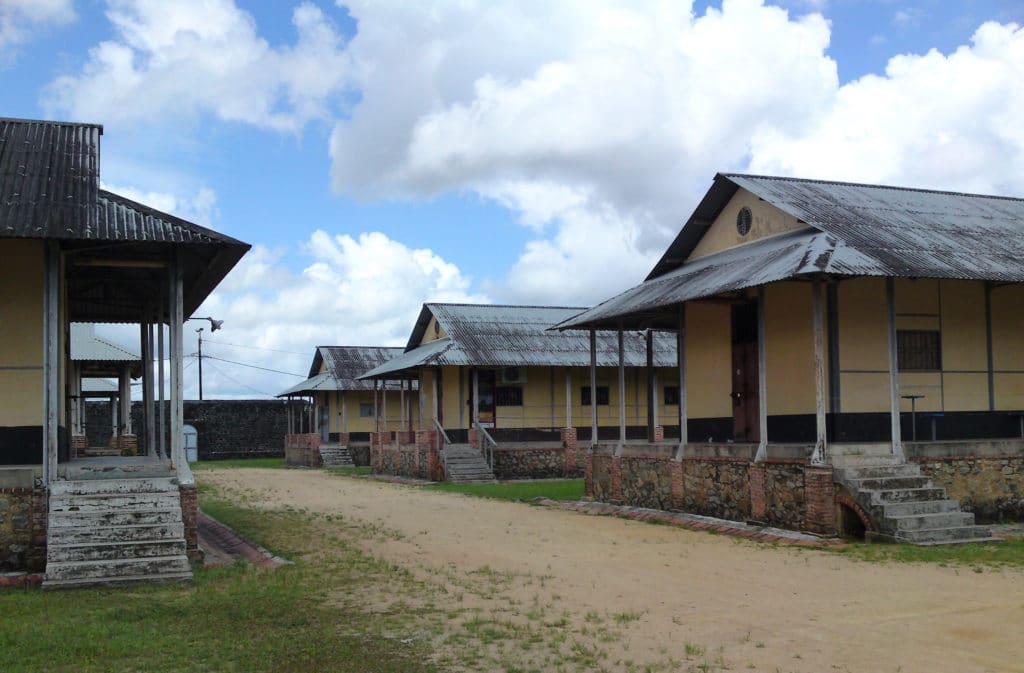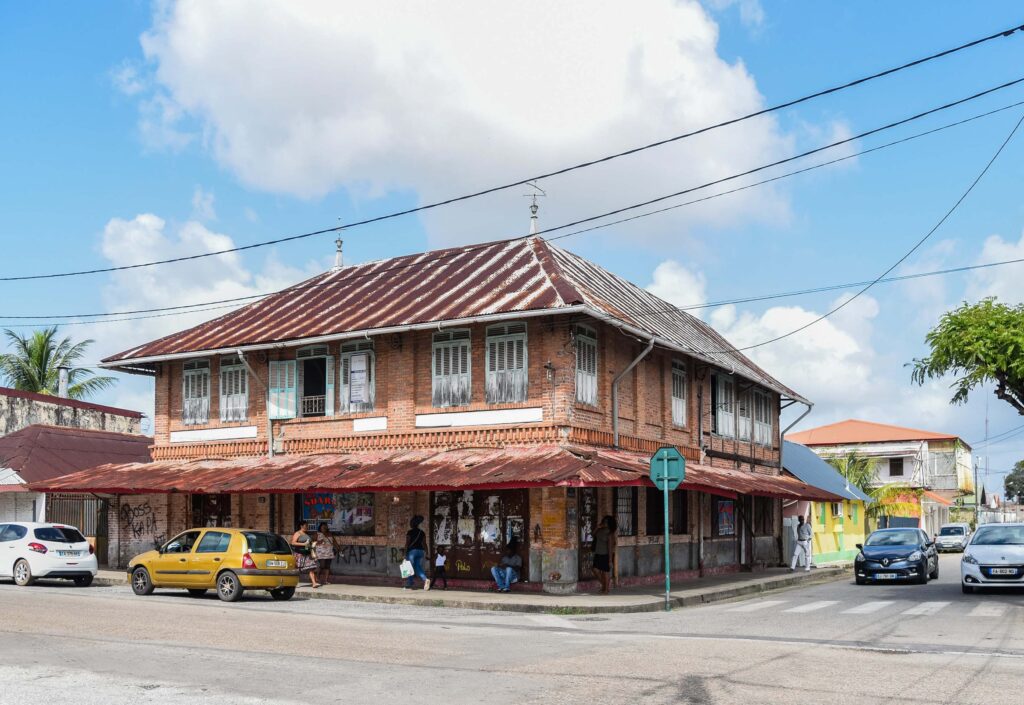Saint-Laurent-du-Maroni is a commune of French Guiana, an overseas region and department of France located in South America. Saint-Laurent-du-Maroni is one of the two sub-prefectures of French Guiana and the seat of the Arrondissement of Saint-Laurent-du-Maroni.
| Country | France |
|---|---|
| Overseas region and department | French Guiana |
| Arrondissement | Saint-Laurent-du-Maroni |
| Government | |
| Mayor (2020-2026) | Sophie Charles |
| Area1 | 4,830 km2 (1,860 sq mi) |
| Population (2018-01-01) | 45,576 |
| Time zone | UTC−03:00 |
Geography
Saint-Laurent-du-Maroni is a border town in north-west French Guiana. It is located on the Maroni River, opposite the town of Albina in Suriname which can be reached by ferry or pirogue. It does not, therefore, have an Atlantic coast; this may have motivated the choice of the town’s location, as the penal authorities wanted to prevent the escape of prisoners from the Prison of St-Laurent-du-Maroni by a sea route.
The ethnic composition of the town is, as everywhere in French Guiana, diverse: Maroons are today the largest ethnic group, followed by Creoles, Amerindians, Haitians, métropolitains and Brazilians.
History
Founded in 1858 by Auguste Baudin, it was formerly the arrival point for prisoners, who arrived at the Camp de la Transportation.

The town was near an Amerindian settlement called Kamalakuli named after their chief. On 15 September 1880, the town became the capital city of a special prison commune; the mayor was the Director of the Penitentiary Administration.
Transport
Between 1890 and 1897, a 16 kilometre Decauville railway was constructed between Saint-Laurent-du Maroni and Saint-Jean-du-Maroni.
Saint-Laurent-du-Maroni can be accessed chiefly by road, the Route Nationale 1, from Cayenne. A new port was recently built on the Maroni, but currently lacks proper wharf infrastructure and sufficient river depth.
In 2010, Route Nationale opened connecting Saint-Laurent-du-Maroni starting from the Plateau des Mines to Apatou. The road was opened with the Tour of Guiana.
The town is also an important port of departure for those going inland via pirogue or to Albina in Suriname by ferry or pirogue.
Economy
The sugarcane fields near town produce “La Belle Cabresse” rum (as well as the less well-known “La Cayennaise” and “Cœur de Chauffe”) for the Saint Maurice rum company. The rum is 50 to 55% proof and of high quality.
On the road to Saint-Jean-du-Maroni south of St-Laurent, home of the former penal Camp de la Rélégation), one can find many small shops owned by Saramakas selling the woodwork for which they are famous – especially chairs and tables.
Two military units are stationed at St-Jean’s Camp Némo: the Groupement du service militaire adapté (GSMA), which is part of the Ministry of Overseas France and is in charge of professional job reinsertion in the west of French Guiana; and the Maroni detachment of the 9th Marine Infantry Regiment whose job it is to patrol the river border and the jungles of the west of the département.
Environment
This river town has long been the headquarters of an important association for the protection of the environment: “Le pou d’agouti” an environmental organisation named after an annoying local mite with an itchy bite which strives for the protection of local and regional fauna and flora.
It is also the point of departure for several ecotourism circuits, most notably journeys upriver to explore the many creeks as well as the Amazonian rainforest; tourists can spend a night in the jungle in huts or tents. Another possibility is visiting the Voltaire Falls, situated 70 km (43 mi) upriver.
Sights
Originally built by, and for, the French department of corrections or Administration Pénitentiaire, many old official buildings in Saint-Laurent-du-Maroni bear a distinctive architectural style, a unique mix of colonial style and penitentiary architecture. Bricks made from the local red clay were used by the convicts, who provided a free and never-ending workforce, to build a whole official and administrative district, starting with the main jailhouse itself, the Camp de la Transportation.
Some of the main buildings in the old administrative district, locally called Le Petit Paris for its alleged reminiscence of a 19th-century French architecture:
- Le Camp de la Transportation (guided tours available, famous for Henri ‘Papillon’ Charrière’s cell) and the adjacent Office du Tourisme;
- La Résidence du Gouverneur du bagne, today’s residence of the sous-préfet, and formerly the governor’s residence;
- Le Tribunal maritime, today’s sous-préfecture;
- La Mairie (city hall) and the former bank;
- St. Lawrence Church;
- Le Trésor public;
- L’Hôtel La Tentiaire;
- La caserne Joffre (the Gendarmerie HQ);
- The hospital (France’s only wooden hospital still in use).

Most of these buildings are located on Avenue De Gaulle, Avenue Lieutenant-Colonel Tourtet and the Boulevard Mallouet. After the jailhouse was closed and the penal authority left in the early 50s, these buildings suffered from lack of maintenance and interest, and were much damaged due to the harsh weather conditions in western French Guiana. It soon became a major tourist attraction, with the Camp de la Transportation its star.
Other notable sights from the penitentiary years include Saint-Jean-du-Maroni, formerly the Camp de la Relégation and today’s main military HQ for western French Guiana. There is also a small island in the middle of the Maroni River which used to house the prisoners affected with leprosy.
Notable sights not related to the prisons:
- La Charbonnière: Maroon village founded by refugees from Suriname’s civil war.
There are many hotels in St Laurent, including the Auberge Bois Diable, Chez Julienne, Hôtel la Tentiaire, Le Relais des 3 Lacs and Star Hôtel.



